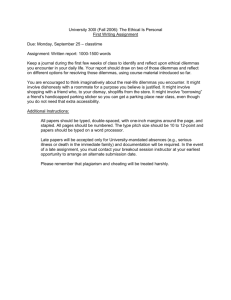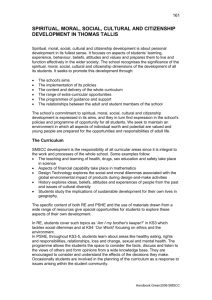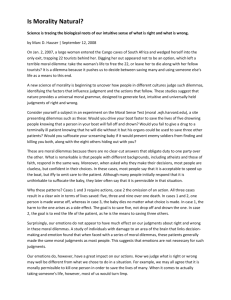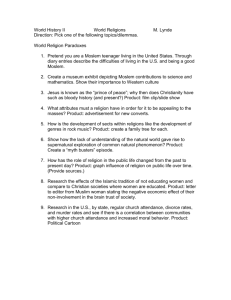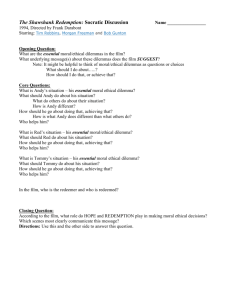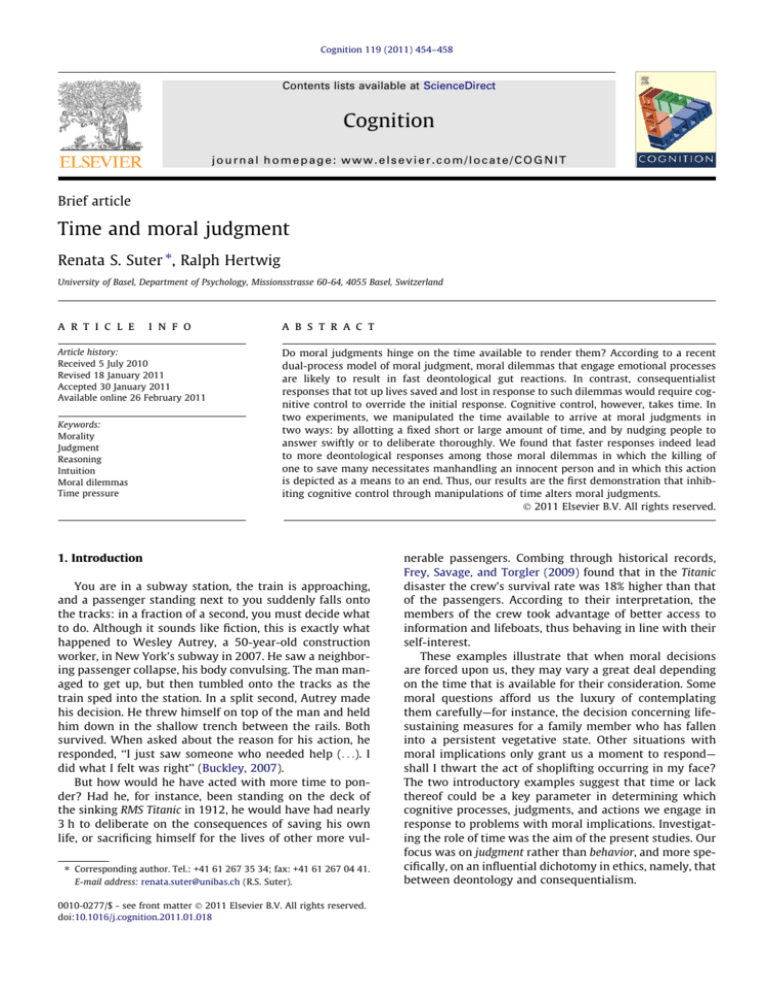
Cognition 119 (2011) 454–458
Contents lists available at ScienceDirect
Cognition
journal homepage: www.elsevier.com/locate/COGNIT
Brief article
Time and moral judgment
Renata S. Suter ⇑, Ralph Hertwig
University of Basel, Department of Psychology, Missionsstrasse 60-64, 4055 Basel, Switzerland
a r t i c l e
i n f o
Article history:
Received 5 July 2010
Revised 18 January 2011
Accepted 30 January 2011
Available online 26 February 2011
Keywords:
Morality
Judgment
Reasoning
Intuition
Moral dilemmas
Time pressure
a b s t r a c t
Do moral judgments hinge on the time available to render them? According to a recent
dual-process model of moral judgment, moral dilemmas that engage emotional processes
are likely to result in fast deontological gut reactions. In contrast, consequentialist
responses that tot up lives saved and lost in response to such dilemmas would require cognitive control to override the initial response. Cognitive control, however, takes time. In
two experiments, we manipulated the time available to arrive at moral judgments in
two ways: by allotting a fixed short or large amount of time, and by nudging people to
answer swiftly or to deliberate thoroughly. We found that faster responses indeed lead
to more deontological responses among those moral dilemmas in which the killing of
one to save many necessitates manhandling an innocent person and in which this action
is depicted as a means to an end. Thus, our results are the first demonstration that inhibiting cognitive control through manipulations of time alters moral judgments.
Ó 2011 Elsevier B.V. All rights reserved.
1. Introduction
You are in a subway station, the train is approaching,
and a passenger standing next to you suddenly falls onto
the tracks: in a fraction of a second, you must decide what
to do. Although it sounds like fiction, this is exactly what
happened to Wesley Autrey, a 50-year-old construction
worker, in New York’s subway in 2007. He saw a neighboring passenger collapse, his body convulsing. The man managed to get up, but then tumbled onto the tracks as the
train sped into the station. In a split second, Autrey made
his decision. He threw himself on top of the man and held
him down in the shallow trench between the rails. Both
survived. When asked about the reason for his action, he
responded, ‘‘I just saw someone who needed help (. . .). I
did what I felt was right’’ (Buckley, 2007).
But how would he have acted with more time to ponder? Had he, for instance, been standing on the deck of
the sinking RMS Titanic in 1912, he would have had nearly
3 h to deliberate on the consequences of saving his own
life, or sacrificing himself for the lives of other more vul⇑ Corresponding author. Tel.: +41 61 267 35 34; fax: +41 61 267 04 41.
E-mail address: renata.suter@unibas.ch (R.S. Suter).
0010-0277/$ - see front matter Ó 2011 Elsevier B.V. All rights reserved.
doi:10.1016/j.cognition.2011.01.018
nerable passengers. Combing through historical records,
Frey, Savage, and Torgler (2009) found that in the Titanic
disaster the crew’s survival rate was 18% higher than that
of the passengers. According to their interpretation, the
members of the crew took advantage of better access to
information and lifeboats, thus behaving in line with their
self-interest.
These examples illustrate that when moral decisions
are forced upon us, they may vary a great deal depending
on the time that is available for their consideration. Some
moral questions afford us the luxury of contemplating
them carefully—for instance, the decision concerning lifesustaining measures for a family member who has fallen
into a persistent vegetative state. Other situations with
moral implications only grant us a moment to respond—
shall I thwart the act of shoplifting occurring in my face?
The two introductory examples suggest that time or lack
thereof could be a key parameter in determining which
cognitive processes, judgments, and actions we engage in
response to problems with moral implications. Investigating the role of time was the aim of the present studies. Our
focus was on judgment rather than behavior, and more specifically, on an influential dichotomy in ethics, namely, that
between deontology and consequentialism.
R.S. Suter, R. Hertwig / Cognition 119 (2011) 454–458
2. Deontology, consequentialism and a dual-process
model of moral judgment
Simply put, consequentialism is the notion according to
which right actions are those that maximize good outcomes; that is, an action should be evaluated solely by reference to the merits of its consequences. Deontology, in
contrast, measures the moral quality of an action in terms
of features of acts other than their outcomes. Specifically,
deontologists emphasize moral rules, most often articulated in terms of rights and duties. This does not mean that
for deontologists, consequences do not matter, rather that
circumstances can arise that require and allow us to take
actions that will not yield the best consequences for all
concerned. For example, a deontologist might say that it
would have been wrong for a crew member of the Titanic
to force a person over the side of an overcrowded lifeboat,
even if doing so saved the lives of several others (Kagan,
1998). Killing one to save many violates this innocent person’s rights or other moral norms.
Psychological investigations into people’s moral judgment have commonly employed moral dilemmas that render possible a classification of people’s binary responses
into those consistent with deontological (adhering to
rights and duties) or consequentialist (maximizing good
outcomes) concerns (e.g., Greene, Morelli, Lowenberg,
Nystrom, & Cohen, 2008). Among those dilemmas, Greene,
Sommerville, Nystrom, Darley, and Cohen (2001) have
drawn a distinction between personal and impersonal moral dilemmas, whereby the crucial difference between the
two lies in the emotional response that they trigger or fail
to trigger and in the associated judgments. Personal dilemmas—for instance, picture an overcrowded lifeboat in
which a crew member throws someone out to keep it
afloat—tend to engage emotional processing to a greater
extent than dilemmas necessitating less personal agency
(e.g., the crew member only needs to hit a switch to remove the passenger). Greene et al. (2001) showed that
impersonal moral dilemmas commonly produce consequentialist responses (i.e., it is right to save more lives),
whereas personal dilemmas are more likely to trigger
automatic, emotional reactions in conjunction with deontological responses (i.e., sacrificing the victim is wrong despite the benefits). Furthermore, within the class of
personal dilemmas, deontological choices are most pronounced when the inevitable harm is perceived to be a
means to an end as opposed to a foreseeable side-effect
of reaching a goal (Cushman, Young, & Hauser, 2006).
To account for this difference, Greene et al. (2001) proposed a dual-process theory of moral judgment. It rests on
the following assumptions. First, there are two kinds of
information processes: controlled cognitive and intuitive
emotional. Second, emotional processes trigger deontological judgments, whereas controlled cognitive processes
tend to prompt consequentialist judgments. Third, processes do not contribute equally in all dilemmas, because
of the dilemma’s varying propensity to evoke and engage
people’s emotions. Fourth, when harmful actions are depicted as sufficiently remote from us (as in impersonal
problems), they fail to push our emotional buttons. Consequently, we think about them in a more cognitive, ‘‘de-
455
tached, actuarial fashion’’ (Greene, 2007, p. 43), making
us more inclined to endorse those actions. In contrast,
when harm is personal—for instance, involves roughing
up a fellow human—alarm-like emotional responses are
triggered, and people are more likely to abjure killing one
to save many.
One prediction following from these assumptions is the
following: Should a consequentialist judgment be reached
in a personal dilemma that engages us emotionally, our
initial deontological impulse must be cognitively controlled. This process of overriding takes time, and requires
the engagement of higher cognitive processes (Greene,
2007). Consistent with this prediction, Greene et al.
(2008) found that participants who responded to personal
dilemmas under the burden of cognitive load and who arrived at consequentialist judgments required more time
relative to a no-load condition. It is noteworthy, however,
that the imposition of cognitive load did not result in fewer
consequentialist judgments, relative to the no-load condition. Consistent with the dual-process model, cognitive
load had no impact on the time needed to reach deontological judgments (see also Greene et al., 2001 and McGuire,
Langdon, Coltheart, & Mackenzie, 2009). Relatedly, Greene,
Nystrom, Engell, Darley, and Cohen (2004) found that contemplation of personal dilemmas, relative to impersonal
dilemmas, selectively recruits emotional circuits, and brain
regions associated with cognitive control showed increased activity preceding consequentialist judgments in
personal dilemmas.
These findings are consistent with the dual-process
model of moral judgment. In none of the experiments, however, was time to reach a judgment directly manipulated.
Previous studies analyzed the response time conditioned
on the deontological or consequentialist judgment (Greene
et al., 2001, 2008). Here we will examine whether people’s
deontological impulse manifests more strongly when less
time is available to recruit controlled cognitive processes
to overturn the impulse. We manipulated time in two
ways: In Experiment 1, we subjected participants to time
pressure; in Experiment 2, we allowed participants to pace
their response time but instructed them either to answer as
quickly as possible, or to deliberate thoroughly. A judge
who deems a personal violent action appropriate as a
means to reach the end of a greater good (e.g., someone
who says ‘‘yes’’ to throwing a person overboard) will, so
the theory goes, have to override a revulsion to manhandling an innocent person. This takes time. If people are
put under time pressure, and thus lack the time to control
their emotional response, then the likelihood of ‘‘no’’ (deontological) responses should increase. However, time pressure should not boost the prevalence of ‘‘no’’ responses in
impersonal (‘‘cold’’) moral dilemmas, and possibly not even
in personal moral dilemmas in which harm is foreseen as a
side-effect of reaching a goal rather than as a means to an
end. In both experiments, we will employ moral dilemmas
that have commonly been used to investigate the tension
between deontology and consequentialism. These dilemmas typically represent a conflict between the rights of another person (e.g., the passenger in a lifeboat who is
targeted to be thrown out) and the good of a larger number
of others (e.g., the other passengers whose lives are saved as
456
R.S. Suter, R. Hertwig / Cognition 119 (2011) 454–458
a consequence). We can thus also investigate to what extent time is critical in conflicts other than those between
self-interest and the greater good of others, which was
the conflict depicted in our introductory examples.
3. Experiment 1
3.1. Method
3.1.1. Participants and design
Sixty-seven psychology students from the University
of Basel (45 women; age range: 17–46 years, M = 24.7,
SD = 5.8) participated for course credit in the study. They
were randomly assigned to either the time-pressure condition (n = 33), in which respondents had to produce their
response within a maximum of 8 s, or the no-time-pressure condition (n = 34), in which respondents took 3 min
to deliberate before answering. The answer was either
‘‘yes’’ (i.e., the consequentialist response) or ‘‘no’’ (i.e.,
the deontological response) in response to the question
of whether they deemed the proposed action to be morally right.
3.1.2. Materials
Based on the results of a pilot study (without time pressure), we selected 10 moral dilemmas (five personal and
five impersonal ones) that about equally likely gave rise
to both yes and no responses, respectively. Dilemmas that
produced predominantly one or the other response were
excluded to reduce the risk of ceiling or floor effects. Participants in each condition responded to all moral dilemmas.
We distinguished personal dilemmas according to whether
harm caused was depicted as a side-effect (low-conflict) or
as intended as the means to an end (high-conflict).1 The personal low-conflict dilemmas were the fireman dilemma and
the boat-action dilemma (see Greene et al., 2009; Hauser,
Tonnaer, & Cima, 2009); dilemmas in the latter category
were the submarine, the crying baby, and the lifeboat dilemma (Greene et al., 2008). As impersonal moral dilemmas we
selected the standard fumes, speedboat, donation, lost wallet, and the boat (side-effect-no-personal-force) dilemmas
(see Greene et al., 2008, 2009). We paraphrased dilemmas
such that no names were mentioned and participants were
not addressed as if they themselves were the actor performing the action.
3.1.3. Procedure
Participants first read the dilemma and could then forward to the next page, where the question appeared. The
description of the dilemma remained on the screen for
maximally 35 s, after which the computer automatically
forwarded to the question screen. Participants in both conditions took, on average, 26.87 (SD = 4.39) and 28.25
(SD = 4.24) s, respectively, to read a dilemma before they
advanced to the question screen. They indicated their
1
Recently, Greene et al. (2009) elaborated on their distinction between
personal and impersonal dilemmas, redefining ‘‘personalness’’ in terms of
‘‘personal force.’’ Moreover, they showed that personal force interacts
critically with the agent’s intention (means versus side-effect).
choice by clicking one of two buttons. The choice could
not be reversed.
In the time-pressure condition, participants had no
more than 8 s to read the question, consider it, and enter
their judgment. Placed above the question, a countdown
indicated the passage of time. After the time had expired,
it was no longer possible to enter a judgment. In the notime-pressure condition, participants were instructed
that they would have 3 min to deliberate, and that they
were not able to respond before the allotted time had
passed.
3.2. Results
In the time-pressure condition, response time was recorded as soon as the question screen appeared. Participants took on average less than 3 s to respond
(M = 2853 ms, SD = 786), and only three participants
missed answering one of the dilemmas. Consistent with
Greene et al.’s (2001) dual-process theory of moral judgment, participants in the time-pressure condition, relative
to the no-time-pressure condition, were more likely to give
‘‘no’’ responses in high-conflict dilemmas. As Table 1
shows, in low-conflict and in impersonal moral dilemmas,
the proportion of ‘‘no’’ responses did not differ between
conditions.2
4. Experiment 2
Recently, Payne, Samper, Bettman, and Luce (2008)
demonstrated—in the context of Dijksterhuis, Bos,
Nordgren, and van Baaren’s (2006) theory of unconscious
thought—that when conscious thought was constrained
to persist for a (artificially) long time its effectiveness
could be impaired. We did indeed make people deliberate
for a long time in the no-time-pressure condition. Yet, the
higher frequency of consequentialist responses—according
to Greene (2007) indicative of a more cognitive, detached,
and actuarial way of thinking—does not suggest that their
moral judgment was impaired. Nevertheless, Experiment 2
examined whether we could replicate Experiment 1’s finding if we nudged respondents to naturally give intuitive
versus deliberate responses via instructions rather than
via constrained processing time.
4.1. Method
4.1.1. Participants and design
Eighty psychology students from the University of Basel
(48 women; age range: 18–49 years, M = 23.3, SD = 5.2)
participated for course credit in the study. They were randomly assigned to the self-paced-intuition (n = 40) and the
self-paced-deliberation condition (n = 40), respectively.
2
As the number of ranks in the Mann–Whitney test was low for personal
low-conflict dilemmas, we also conducted an analysis using chi-square
statistics. The pattern remained the same, with a significant difference
between conditions for personal high-conflict dilemmas, v 2 (3,
N = 67) = 7.27, p = .032 (one-tailed), V = .33, and no difference between
conditions for personal low-conflict or impersonal dilemmas, respectively.
457
R.S. Suter, R. Hertwig / Cognition 119 (2011) 454–458
Table 1
Average proportion of ‘‘No’’ responses (deontological responses) separately for conditions and type of moral dilemma (high- versus low-conflict personal and
impersonal dilemmas) in Experiments 1 and 2.
Experiment 1
Dilemma type
Personal
High conflictb
Low conflictc
Impersonal
Time-pressure (n = 33)
No-time-pressure (n = 34)
Statistics
M
M
U
0.52
0.21
0.42
0.31
0.26
0.35
364.00
549.50
423.50
Self-paced-intuition (n = 40)
Self-paced-deliberation (n = 40)
Statistics
M
M
U
0.50
0.22
0.41
0.32
0.26
0.39
587.50
724.00
743.50
z
p
2.556
0.166
1.466
ra
.011
.868
.143
0.31
0.02
0.18
Experiment 2
Dilemma type
Personal
High conflictb
Low conflictc
Impersonal
a
b
c
z
p
2.125
.840
.579
.034
.401
.563
ra
0.24
0.09
0.06
This column indicates the effect size r; r = .1 indicates a small, r = .3 a medium, and r = .5 a large effect.
High-conflict personal dilemmas are ones in which harm is depicted as means to an end.
Low-conflict personal dilemmas are ones in which harm is depicted as a side-effect.
4.1.2. Materials and procedure
Materials and procedure were identical to Experiment
1. Participants in the self-paced-intuition condition were
instructed to answer all questions as quickly and intuitively as possible. In the self-paced-deliberation condition,
participants were told that they could take as much time
as they desired to deliberate. Participants in both conditions took, on average, 28.98 (SD = 4.66) and 27.61
(SD = 3.89) s, respectively, to read a dilemma before they
advanced to the question screen.
4.2. Results
In both conditions, response time was recorded as soon
as the question screen appeared. Participants in the selfpaced-deliberation condition took about three times longer to respond (M = 12,092 ms, SD = 20,947) than those in
the
self-paced-intuition
condition
(M = 4452 ms,
SD = 2721), t(41.38) = 2.32, p = .026, 95% CI (0.993,
14.288). Consistent with the results in Experiment 1, in
personal high-conflict dilemmas faster responses were
more likely to be deontological than slower responses. As
Table 1 shows, no such trend occurred for personal lowconflict problems and for impersonal problems, respectively.3 Fig. 1, in which we collapsed the proportion of deontological responses in Experiments 1 and 2 across fast and
slow conditions, respectively, depicts the interaction between time taken to reach a response and type of dilemma.
5. Conclusion
We employed two methods to manipulate the time
available to people before responding to moral dilemmas.
3
As in Experiment 1 (see Fn 2), we conducted a chi-square analysis and
observed the same pattern of results: a significant difference for personal
high-conflict dilemmas, v2(3, N = 80) = 6.93, p = .037 (one-tailed), V = .29,
and no difference for personal low-conflict or impersonal dilemmas,
respectively.
Fig. 1. Average proportion of deontological responses separately for
conditions and type of moral dilemma (high- versus low-conflict personal
and impersonal dilemmas) with data combined across the fast (i.e., timepressure and self-paced-intuition) and slow conditions (no-time-pressure
and self-paced-deliberation) in Experiments 1 and 2, respectively. Error
bars represent standard errors. Only responses to high-conflict dilemmas
differed significantly between the conditions (see Table 1).
First, we pressured them to answer quickly or to deliberate
protractedly by defining a fixed-time budget. Second, we
allowed participants to pace their response times themselves but nudged them to answer intuitively and swiftly
versus to deliberate for as long as they desired. Across both
time manipulations, the prevalence of deontological responses increased when people responded faster. This effect of time on the actual moral judgment, however, only
occurred for those personal dilemmas portraying harm as
a means to an end, but not in personal problems with harm
depicted as a side-effect or in impersonal problems.
To the best of our knowledge, ours is the first demonstration of the impact of time on moral judgment. Specifically, the results suggest that when the time to cognitively
control the first moral gut response is lacking or is not invested, the likelihood of deontological response increases,
consistent with Greene et al.’s (2001, 2008) dual-process
model of moral judgment. On this view and consistent
458
R.S. Suter, R. Hertwig / Cognition 119 (2011) 454–458
Table 2
Average proportion of ‘‘No’’ responses (deontological responses) in the unconscious-thought condition (UT) relative to the average proportions of conditions in
Experiments 1 and 2.
Comparison to the unconscious-thought condition (n = 34)
Condition
Time-pressure
No-time-pressure
Self-paced-intuition
Self-paced-deliberation
MExperiments
0.52
0.31
0.50
0.32
1 and 2
MUT
U
b
0.31
0.31b
0.31b
0.31b
366.00
572.00
488.00
665.00
z
p
2.532
0.078
2.164
0.172
.011
.938
.030
.863
ra
0.309
0.009
0.252
0.021
Note: Judgments of low-conflict personal and impersonal dilemmas did not differ significantly between conditions (all ps > .05). Displayed are judgments of
high-conflict personal dilemmas.
a
This column indicates the effect size r; r = .1 indicates a small, r = .3 a medium, and r = .5 a large effect.
b
The results in the UT condition were compared to each of the other conditions (column MExperiments 1 and 2); therefore, all entries in the column MUT refer
to the same data.
with our results, time (or lack thereof) acts as a gatekeeper
that determines whether cognitive control processes can
unfold. Interestingly, however, cognitive control processes
do not have to be conscious. In an additional condition, we
instructed participants to give intuitive judgments after
3 min of distraction (see Dijksterhuis et al., 2006). These
judgments are hypothesized to be based on unconscious
thought, which is assumed to process information automatically during the time of distraction (Dijksterhuis
et al., 2006). Such unconscious thought processes also appear to be able to control the first moral gut response:
Judgments of personal high-conflict dilemmas were significantly more likely to be consequentialist relative to the
time-pressure and the self-paced-intuition conditions in
Experiments 1 and 2, respectively (Table 2; see also Ham
& van den Bos, 2010).
Our studies are consistent with the view that consequentialist choices represent a victory of a cognitive costbenefit analysis over an emotional impulse. Yet, we have
not recorded emotional processes, and it is quite possible
that processes other than emotions mediate intuitive moral judgments (see Huebner, Dwyer, & Hauser, 2009). Notwithstanding this ongoing debate, what we are beginning
to discern is that our moral decision-making is time sensitive: time mediates the judgment that is reached.
Acknowledgments
We thank Laura Wiles for editing the manuscript and
the Swiss National Science Foundation for a grant to the
second author (100014_125047/2).
References
Buckley, C. (2007). Man is rescued by stranger on subway tracks. The New
York Times, January 3. <http://www.nytimes.com>.
Cushman, F., Young, L., & Hauser, M. (2006). The role of conscious
reasoning and intuition in moral judgment: Testing three principles
of harm. Psychological Science, 17, 1082–1089. doi:10.1111/j.14679280.2006.01834.x.
Dijksterhuis, A., Bos, M. W., Nordgren, L. F., & van Baaren, R. B. (2006). On
making the right choice: The deliberation-without-attention effect.
Science, 311, 1005–1007. doi:10.1126/science.1121629.
Frey, B. S., Savage, D. A., & Torgler, B. (2009). Surviving the Titanic
disaster: Economic, natural and social determinants. Center for
Research in Economics, Management and the Arts (CREMA). <http://
www.crema-research.ch/papers/papers09.htm>.
Greene, J. D. (2007). The secret joke of Kant’s soul. In W. SinnottArmstrong (Ed.). Moral psychology. The neuroscience of morality:
Emotion, brain disorders, and development (Vol. 3, pp. 35–80).
Cambridge, MA: MIT Press.
Greene, J. D., Cushman, F. A., Stewart, L. E., Lowenberg, K., Nystrom, L. E., &
Cohen, J. D. (2009). Pushing moral buttons: The interaction between
personal force and intention in moral judgment. Cognition, 111,
364–371. doi:10.1016/j.cognition.2009.02.001.
Greene, J. D., Morelli, S. A., Lowenberg, K., Nystrom, L. E., & Cohen, J. D.
(2008). Cognitive load selectively interferes with utilitarian moral
judgment. Cognition, 107, 1144–1154. doi:10.1016/j.cognition.2007.
11.004.
Greene, J. D., Nystrom, L. E., Engell, A. D., Darley, J. M., & Cohen, J. D.
(2004). The neural bases of cognitive conflict and control in moral
judgment. Neuron, 44, 389–400.
Greene, J. D., Sommerville, R. B., Nystrom, L. E., Darley, J. M., & Cohen, J. D.
(2001). An fMRI investigation of emotional engagement in moral
judgment. Science, 293, 2105–2108. doi:10.1126/science.1062872.
Ham, J., & van den Bos, K. (2010). On unconscious morality: The effects of
unconscious thinking on moral decision making. Social Cognition, 28,
74–83. doi:10.1521/soco.2010.28.1.74.
Hauser, M. D., Tonnaer, F., & Cima, M. (2009). When moral intuitions are
immune to the law: A case study of euthanasia and the act-omission
distinction in the Netherlands. Journal of Cognition and Culture, 9,
149–169. doi:10.1163/156770909X12489459066147.
Huebner, B., Dwyer, S., & Hauser, M. (2009). The role of emotion in moral
psychology. Trends in Cognitive Sciences, 13, 1–6. doi:10.1016/j.tics.
2008.09.006.
Kagan, S. (1998). Normative ethics. Boulder, CO: Westview Press.
McGuire, J., Langdon, R., Coltheart, M., & Mackenzie, C. (2009). A
reanalysis of the personal/impersonal distinction in moral
psychology research. Journal of Experimental Social Psychology, 45,
577–580. doi:10.1016/j.jesp. 2009.01.002.
Payne, J. W., Samper, A., Bettman, J. R., & Luce, M. F. (2008). Boundary
conditions on unconscious thought in complex decision making.
Psychological Science, 19, 1118–1123. doi:10.1111/j.1467-9280.2008.
02212.x.


